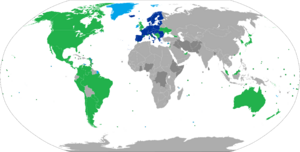Visa policy of the Schengen Area facts for kids
The Schengen Area is like a big club of European countries that have agreed to let people travel freely between them without needing to show their passport at every border. Think of it as one big country for travel purposes!
The rules for who can enter this club, and whether they need a special permission called a "visa," are called the visa policy of the Schengen Area. These rules are a big part of how the European Union helps people move around safely and easily.
Most countries in the European Union are part of the Schengen Area. There are also a few non-EU countries that are members, like Iceland, Liechtenstein, Norway, and Switzerland.
If you're from certain countries, you can visit the Schengen Area for up to 90 days within any 180-day period without needing a visa. This is great for tourists and short visits! However, people from other countries need to get a visa before they can enter. Sometimes, they even need a visa just to pass through a Schengen country on their way to somewhere else.
Ireland is an EU country, but it has its own separate rules for visas and is not part of the Schengen Area.
People who are citizens of countries within the EU single market (which includes most Schengen countries) have a special right. They can not only visit but also live and work in any other EU country without needing a visa. This is called "freedom of movement."
Understanding the Schengen Visa Map
This map helps us see which countries are part of the Schengen Area and what the general visa rules are.

- The dark blue areas show the main Schengen countries.
- The light blue areas show other EU countries or territories that also have free movement with the Schengen Area.
- The green areas show countries whose citizens can usually visit the Schengen Area without a visa for short trips.
- The grey areas show countries whose citizens need a visa to visit the Schengen Area.
What is a Schengen Visa?
A Schengen visa is a special sticker placed in your passport. It allows you to travel to any of the Schengen countries. It's like having one visa for many countries, which makes travel much easier!
When you enter the Schengen Area, you might get a stamp in your passport. This stamp shows when and where you entered.
Images for kids
See also
 In Spanish: Política de visados del espacio Schengen para niños
In Spanish: Política de visados del espacio Schengen para niños
- European Travel Information and Authorisation System
- Visa Information System
- Visa policy of Ireland
- Visa requirements for European Union citizens



